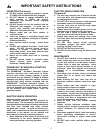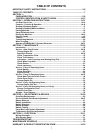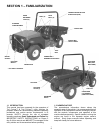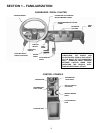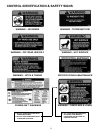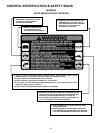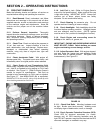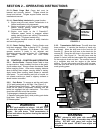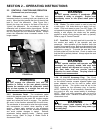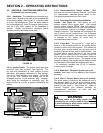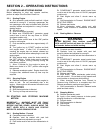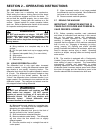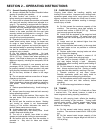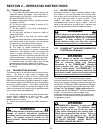
13
SECTION 2 – OPERATING INSTRUCTIONS
2.1 PRE-START CHECK LIST
Make the following checks and perform all service as
required before starting and operating the machine.
2.1.1. Read Manuals. Read, understand, and follow
instructions and warnings in this manual and all other
supplied manuals, as well as instructions and warnings
on the machine, engine and attachments. Know the
controls and the proper use of the machine before
starting.
2.1.2. Perform General Inspection. Thoroughly
inspect the entire machine for damage, wear, and loose
and missing hardware. Repair or replace damaged,
worn, loose and missing components prior to starting
and operating machine.
2.1.3. Check Tires. Check and adjust tire pressure to
15 psi. front and rear. Inspect condition of tires for
wear, deterioration, cuts, and damage. Replace worn,
damaged or deteriorated tires before operating
machine, using only tires of original size, type and
construction.
2.1.4. Check Accelerator Pedal. With engine off,
depress pedal fully. The pedal must move freely, and
immediately return to original position when released.
2.1.5. Check Engine oil and Transmission fluid.
Raise empty cargo bed and carefully secure with prop
rod. Add oil as needed to bring engine to FULL mark
on dipstick. See Figure 2.1. Refer to Engine Owner’s
manual for engine oil specifications. Add fluid as
needed to bring transmission to FULL mark on dipstick.
See Figure 2.1. Use MOBILFLUID 424 or equivalent.
IMPORTANT! Do Not overfill. Always fully thread dip stick
when checking transmission fluid levels.
FIGURE 2.1
2.1.6. Add Fuel to tank. (Refer to Engine Owner’s
manual for fuel specifications.) Make sure fuel filler cap
is tight after fueling. IMPORTANT NOTE: Always fuel
machine out of doors, where fumes can safely
dissipate. Do not smoke while fueling.
2.1.7. Check Steering for excessive play. Do not
operate machine if steering is loose or sloppy.
2.1.8. Check Headlights. Both headlights should be
functional before operating machine. Headlight lenses
and rear reflectors must be clean. (NOTE: Ignition
must be set to ‘Run’ position for headlights to function.)
2.1.9. Check Engine and surrounding areas for
buildup of dirt, debris, oil, grease, etc.
IMPORTANT! ENGINE AND SURROUNDING AREAS
MUST BE KEPT CLEAN. Debris buildup can cause
engine overheating, severe damage, and fire.
2.1.10. Adjust Operator’s Seat. With engine stopped,
and park brake set, loosen two seat adjusting knobs
and move seat to desired position. Re-tighten both
knobs securely. See Figure 2.2.
FIGURE 2.2
2.1.11. Check Seat Belts. Mounting hardware must
be tight. Buckle must latch securely. Webbing must
not display signs of deterioration, wear, or damage.
2.1.12. Check Operator Protective Structure (OPS).
Check OPS for structural soundness (i.e. cracks,
damage, etc.) All OPS mounting hardware must be
tight. DO NOT operate a machine that has had the OPS
removed, damaged, or modified in any way.
SEAT ADJUSTING
KNOBS
ENGINE
OIL FILL
TRANSMISSION
FLUID
DIPSTICK/FILL
ENGINE
OIL
DIPSTICK
13



